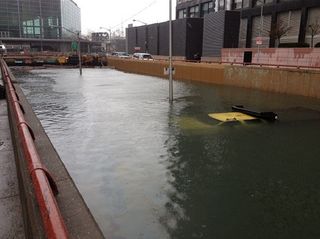
America's Busiest Airports at Risk from Sea Level Rise

During Hurricane Sandy, the ocean tried to take back the marshlands under New York's LaGuardia Airport. Parts of the airport's east-west runway and tarmac disappeared under Hurricane Sandy's storm surge. The severe flooding was due to a combination of factors: Sea-level rise caused by global warming, a high tide, and the storm's savagery, according to the National Oceanic and Atmospheric Administration (NOAA).
New York's major airports are among the 12 coastal hubs at risk of future storm flooding linked to sea level rise, according to a draft federal report, Climate Central reported. As sea levels inch higher at the coast, storms will cause more damage by pushing further inland, pounding critical infrastructure such as airports, power plants, highways and bridges. Twelve airports have runways within 12 feet (3.6 meters) of current sea level, according to the draft National Climate Assessment report. The list includes:
- Ft. Lauderdale Int'l (FLL)
- Honolulu International (HNL)
- John F. Kennedy Int'l (JFK)
- LaGuardia (LGA)
- Miami Int'l (MIA)
- New Orleans Louis Armstrong Int'l (MSY)
- Newark Liberty Int'l (EWR)
- Oakland International (OAK)
- Philadelphia Int'l (PHL)
- Ronald Reagan Washington National (DCA)
- San Francisco Int'l (SFO)
- Tampa International (TPA)
Read more: National Climate Assessment
Email Becky Oskin or follow her @beckyoskin. Follow us @livescience, Facebook & Google+.
Sign up for the Live Science daily newsletter now
Get the world’s most fascinating discoveries delivered straight to your inbox.

Most Popular




